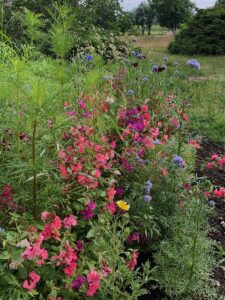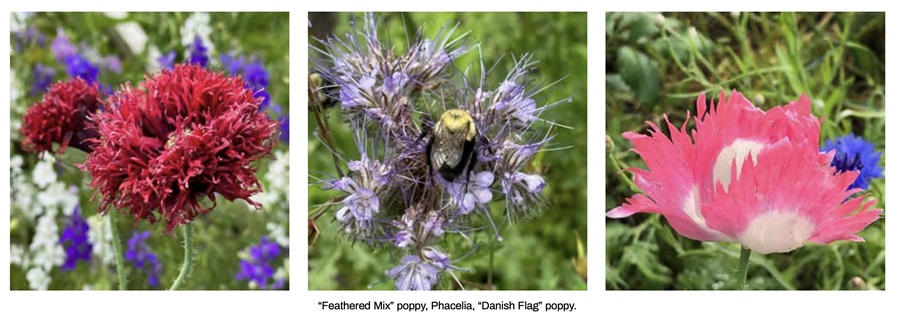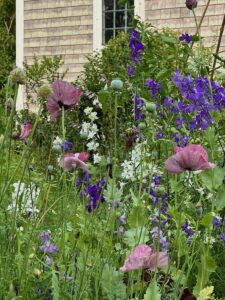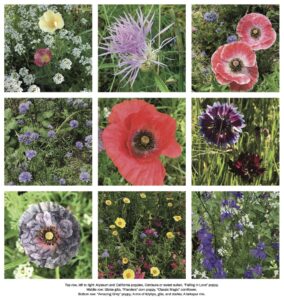The first time I walked outside on a late February morning and scattered a packet of poppy seeds on the snow I felt the same way I did the few times I’ve been to a casino — like I was throwing money on the ground. I had no idea when or even if the seedlings would come up.
But in May, the payoff arrived without any help from me. The previously bare patch of soil near my front door erupted in a medieval tapestry of airy cornflowers, clarkia, phacelia, tidytips, gilia, sweet sultan, and, of course, poppies of all kinds. I was enchanted by a new (to me) category of plants: hardy annuals.

Horticulturally, this term means the seeds will germinate in, or at least not be damaged by, the low temperatures of most winters and early springs (that’s the hardy part) while living only one growing season before setting seed (the annual part).
Some gardeners I meet are turned off by the idea of annuals, thinking that they are a waste of time and money because they must be replaced every year. But unlike many perennials, which bloom only for a short time, annuals bloom their cheerful little heads off in a live-fast-die-young kind of frenzy. They’re built to procreate. I’ve grown to love them for their ease but also because they’re cheap. Seed packets range from a couple of bucks to five or six dollars for the more fashionable varieties.
I am still experimenting with what will reliably grow from seed on the Outer Cape, but so far, the evidence suggests that this is a perfect place for these plants. Our winters aren’t super cold, except for the rare below-zero cold snap. Our soils are well drained. Spring provides plenty of rainfall. The sea breezes are moist and gentle — unless there’s a raging storm.
 All that’s required from the gardener is to open the seed packet and scatter the seeds in the areas where you want them to grow. Most annuals don’t like competition. The seeds will get lost and not thrive in an established bed, so I either clear an area of plants or dump several inches of soil and compost on top of bare earth to get the most success. Keep in mind that shorter varieties like California poppies, alyssum, clarkia, and phacelia need to be sown at the front of the beds so they don’t get lost among taller types.
All that’s required from the gardener is to open the seed packet and scatter the seeds in the areas where you want them to grow. Most annuals don’t like competition. The seeds will get lost and not thrive in an established bed, so I either clear an area of plants or dump several inches of soil and compost on top of bare earth to get the most success. Keep in mind that shorter varieties like California poppies, alyssum, clarkia, and phacelia need to be sown at the front of the beds so they don’t get lost among taller types.
Larkspurs are one of my favorite hardy annuals, but they’d been playing hard-to-get for me until last year. Of course, that only made me want these dainty versions of delphiniums more, especially the mixed blue hybrids and the lilac-gray “Smokey Eyes.” For two seasons I had trouble getting them to germinate. After a little research, I learned that they might benefit from a process called cold moist stratification to break their dormancy.

In deep winter, I placed the larkspurs in sealed jars with a bit of damp soil and kept them in the refrigerator for about a month, just until I saw them start to sprout. Then I put them out in a cleared patch that was free of any competing weeds and lightly tucked them into the soil. It worked. By late June I had a robust tangle of larkspurs, which will, I hope, self-seed next year, the way many hardy annuals do.
Most direct-seeded annuals don’t require such special consideration. They just want water, sun, and good soil. If I stagger my hardy annual plantings and then follow them with half-hardy varieties such as cosmos, zinnias, and balsam impatiens in May, I’ll get continuous blooms till frost. That’s especially true with heat-loving cosmos, which come in a dazzling array of colors and in forms that grow so tall that they’ll be dancing above your head by late August.
That takes me back to annual poppies. I’m obsessed with this remarkable group of plants, from the robust breadseeds to the Shirleys, in all their colors and forms, from the scarlet singles to the pastel-fringed doubles and from bright pompoms to the silvery ruffles of Amazing Grey. These wonders possess incredible genetic variation with hues and forms that morph and switch even within named hybrids. How can such flamboyance emerge from such a tiny dot of a seed?
Reliable specialists in hardy annual seeds, including Select Seeds, Johnny’s Selected Seeds, Eden Brothers, and Rare Seeds, can get you started. But one last note to add to the fun of growing hardy annuals is that you can save your seeds. Once the flowers have browned and dried, gather as many seeds as you can on a sunny day and put them in individual envelopes or sealed jars. The next winter, when it’s time to snow sow, you’ll have a ready supply.
